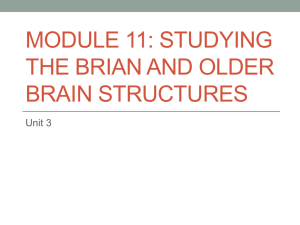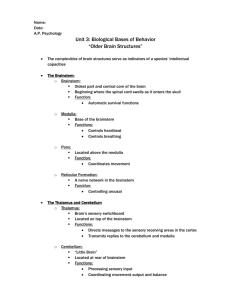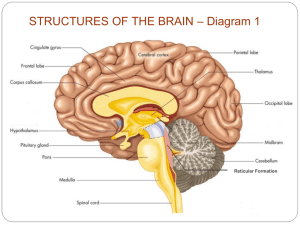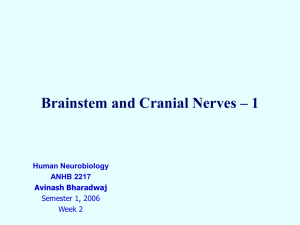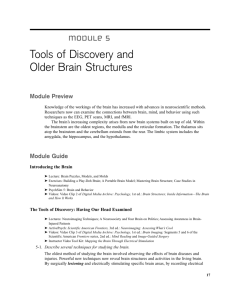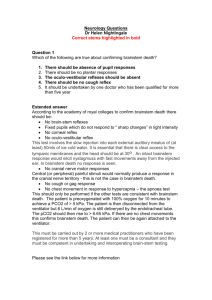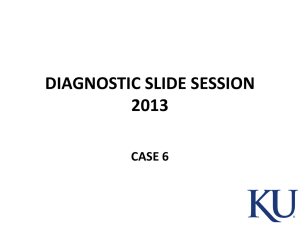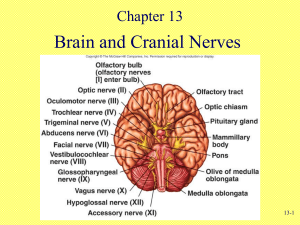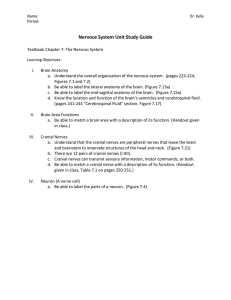007 CNS lecture 7 Brainstem Dr Shahab
advertisement
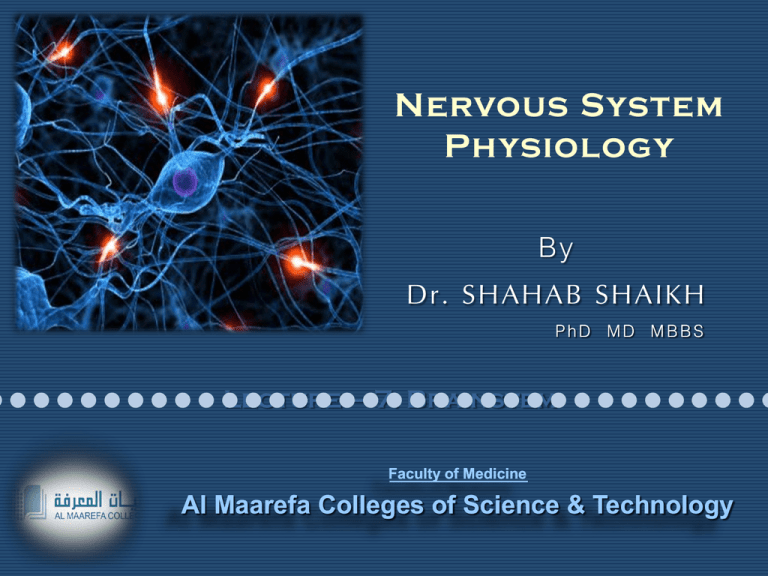
Nervous System Physiology By Dr. SHAHAB SHAIKH PhD MD MBBS Lecture – 7: Brainstem •••••••••••••••••••••••••••••••••• Faculty of Medicine Al Maarefa Colleges of Science & Technology Objectives • Describe the components of Brain stem. • Enumerate different functions of brainstem. • Know the reticular formation and its activating & inhibiting system • Role of brainstem in brain death. 2 Brainstem Brain Stem consists of 1. Mid brain 2. Pons 3. Medulla 3 Functions of Brainstem • The nerve connections of the motor and sensory systems between the main part of the brain to the rest of the body pass through the brainstem. • Has role in Regulation of muscle reflexes involved with equilibrium and posture • Reception and integration of all synaptic input from spinal cord 4 Functions of Brainstem • Origin of majority (10) of cranial nerves is in Brainstem • Cranial nerves arising from brain stem – Mid-brain – Pons – Medulla – III, IV – V, VI, VII, VIII – IX, X, XI, XII • The brainstem provides the main motor and sensory innervation to the face and neck via the cranial nerves. • Note only Cranial nerves I (Olfactory) & II (Optic) do not have any origin from Brainstem 5 Functions of Brainstem • It also regulates the central nervous system, and is Important in . . . – Arousal and Activation of cortex, – Maintaining Consciousness and – Regulating the Sleep cycle. • Centers for Cardiovascular, Respiratory, and Digestive control are located in Brainstem • Thus basic functions controlled from Brainstem Include … – – – – – Heart Rate & Blood Pressure, Breathing including Cough & Sneezing Sleep, wakefulness, Consciousness Digestive activities including swallowing, vomiting Posture & Equilibrium 6 Cranial Nerves 7 Cranial Nerves No. Cranial Nerve Major Functions I Olfactory Smell II Optic Vision III Oculomotor Eyelid and Eyeball Movement Trochlear Innervates Superior Oblique Turns Eye Downward and Laterally V Trigeminal Chewing Face & Mouth Touch & Pain VI Abducens Turns Eye Laterally Facial Controls Most Facial Expressions Secretion Of Tears & Saliva Taste IV VII 8 Cranial Nerves No. Cranial Nerve VIII Vestibulocochlear (Auditory) Hearing Equilibrium Sensation Glossopharyngeal Taste Senses Carotid Blood Pressure Vagus Senses Aortic Blood Pressure Slows Heart Rate Stimulates Digestive Organs Taste XI Spinal Accessory Controls Trapezius & Sternocleidomastoid Controls Swallowing Movements XII Hypoglossal Controls Tongue Movements IX X Major Functions 9 Functions of Brainstem - CVS • Cardiovascular center (Vasomotor Center) – It controls Myocardial contractility – Controls Blood Pressure – Controls diameter of blood vessels 10 Functions of Brainstem - RS Respiratory centers • Medulla – – DRG - Inspiratory and – VRG – Expiratory center • Pons – – Apneustic center – Pneumotaxic center 11 Functions of Brainstem - RAS 12 Functions of Brainstem - Summary • • • • • • • Alertness • eye movement, and body movement. Arousal • Relays Information Sleep/Wakefulness Between the Respiratory Center Peripheral Nerves and Cardiovascular Center Spinal Cord to the Digestion center Upper Parts of the Tone, Posture & Brain Equilibrium • Cranial Nerves • Autonomic Functions Brain stem subconsciously controls • Visual reflex center many life sustaining processes such as respiration, circulation, and • Auditory reflex center digestion. These are referred as vegetative functions 13 Brain Death • As per the ‘Uniform Determination of Death Act’ of USA, “Brain death is complete & irreversible cessation of all Brain (cerebrum & Brainstem) functions including involuntary activity necessary to sustain life”. • While in UK, the Royal College of Physicians defines death based on the irreversible loss of brain stem function alone (Brainstem Death). • Brain death is used as legal definition of Death in many jurisdictions. • It is a different state from biological death. It is often possible to maintain respiratory and circulatory activity if resuscitative measures are started soon 14 Brain Death • The determination that comatose patient maintained by artificial respiration and other supportive measure is alive or dead has important medical, legal, and social implications. • It is important to distinguish between brain death and states that may be difficult to differentiate from brain death (such as barbiturate overdose, alcohol intoxication, sedative overdose, hypothermia, hypoglycemia, coma, and chronic vegetative states). • The continuing function of vital organs in the bodies of those diagnosed brain dead, if mechanical ventilation and other life-support measures are continued, provides optimal opportunities for their 15 transplantation. Brain Death EEG RECORDING SHOWING WAVES EEG RECORDING - FLAT 16 Brain Death Once the brain stem has permanently irreversibly stopped functioning, the heart will eventually stop beating even if a ventilator has been used 17 References • Human physiology by Lauralee Sherwood, 8th edition • Text Book Of Physiology by Guyton & Hall, 11th edition THANK YOU 19
